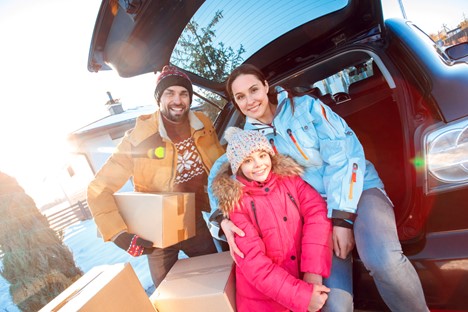Moving Somewhere Colder? Watch Out for Icy Surprises
 By Julie DeLong, A-1 Freeman Moving Group
By Julie DeLong, A-1 Freeman Moving Group
You may find yourself suddenly driving on icy roads. Your driveway at the new place may be frosted with snow, and you may find that unloading the truck is a much colder experience than loading up in your original warmer location. As professional movers, we know how important it is to understand the risks of moving in a new icy environment and how to stay safe during your relocation to somewhere colder.
- Pack for a Cold Road Trip
- Be Prepared for Ice on the Road
- Prep the House for an Icy Move-In
Packing for a Road Trip that Gets Colder
Heading north or to a higher elevation? Pack for a road trip that gets colder the closer you get to your new home. Prepare for temperatures to drop and for ice to suddenly become normal.
Pack Extra Sweaters for the Trip
Pack warm layers like extra sweaters and socks. Have a warm hat ready when your ears feel the cold or pick up a warm hat on your way into colder climes. Be prepared for that first gas stop where the wind suddenly leaves you chilled to the bone. We've all been there.
Check Your Tire Treads
Before you head out, check your tire treads. Bare tires may be perfectly safe in warm, dry climates but become a serious risk with any amount of ice or frost on the road. Do the penny test: Stick a penny upside-down into your treads. If the treads reach just past the top of President Lincoln's head, you're OK.
Safe Driving into Winter Climates
Be careful out on the road as you transition to a colder region! All too often, the first icy patch will catch a relocating warm-climate native by surprise. Drive carefully when the temperature drops below 40 degrees. Slow down and gently guide your vehicle in the right direction if you start to slip.
Watch Out for Black Ice on the Roads
Black ice is an invisible killer. It is ice just thin enough that it looks exactly like the pavement. If the other drivers slow down and you can see frost on the roadside grass, watch out. Go with the flow, do not try to pass in an icy region when the locals drive carefully.
All-Weather Tires and Tire Chains
If you replace bald tires, choose winter-ready or all-weather tires. If your route goes through a mountain pass, you might even need tire chains. If you don't have tire chains, this could mean an unscheduled stop at the nearest town to pick some up, and then learn how to use them.
Be Prepared for an Icy Move-In
When you get to the new house, it is likely to be freezing cold, and there may be a slippery layer of ice on your driveway. Neither are good conditions for moving in. Here's how to get your house ready for a warm, safe unloading:
Check for Ice on the Pavement and Grass
Check the pavement for ice. You can usually tell by the crunch, a quick stomp, or touching it with your fingers. Also check the grass. Ice can be very thin and hard to spot but can also cause seriously harmful slips while carrying boxes and furniture.
Warm Up the House Before the Moving Truck Arrives
Have your power switched on before you arrive. Then as soon as you unlock the door, fire up the heater to make the house a safe place to warm up as you unpack. There may be the smell of burnt dust for 10 to 40 minutes. Don't worry, this is normal, and your home will be cozy warm soon.
Lay Driveway Salt, Mats, and Floor Protection as Needed
If it's icy outside, this is bad news for movers and your floors. Sprinkle driveway salt (or non-salt de-icer) on the pavement. Then place a heavy-duty welcome mat in front of the door to stomp-off sharp ice and salt particles. Finally, if needed, lay protective mats or towels on the floors. This is especially important if there is wet snow.
Check the Weather on Move-In Day
Be sure to check the weather report on move-in day so you know if it will get warmer or colder as the day goes on.
Boxes, Ice and Damp
On a special note, protect your boxes during the unloading. Do not place boxes on ice, they will pick up ice, which will then melt and make your boxes soggy. Likewise, snow can be brushed off at first but can quickly dampen your boxes as well. If you need to unload onto the driveway, lay down a tarp or cover. If there is any precipitation, cover your boxes as they are carried inside.
Cold Weather Health Tips for Warm Weather People
- Dress in warm layers
- Stay hydrated
- Make warm drinks
- Pace yourself
Finally, keep yourself safe and warm. People from warm climates, like us, often don't realize how dangerous the cold can be to your health. Dress in warm layers and remove or add sweaters based on your personal body temperature as you move boxes. Be sure to stay hydrated, cold and heaters are moisture-sapping. Keep a water bottle handy and don't be afraid to make pot after pot of tea, cocoa, or cider.
If you need to rest, take a 5-minute break from both the cold and the heavy-lifting by doing a little strategic (seated) unpacking of essentials.
Here at A-1 Freeman Moving Group, we know that interstate moves to colder climates can be tough. Many people have no idea what to expect, or that relocating for work or family might lead to a completely different wintertime experience. Stay safe and warm this relocation and count on our team to make sure your possessions make it through sleet, snow, and icy roads without worry.
Request a free quote
